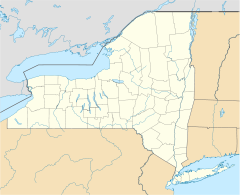- Cyrus Gates Farmstead
-
Gates, Cyrus, Farmstead
 Cyrus Gates Farmstead, 1963
Cyrus Gates Farmstead, 1963Nearest city: Maine, New York Coordinates: 42°14′50″N 76°2′19″W / 42.24722°N 76.03861°WCoordinates: 42°14′50″N 76°2′19″W / 42.24722°N 76.03861°W Area: 130 acres (53 ha) Built: 1848 Architectural style: Greek Revival Governing body: Private NRHP Reference#: 98001549[1] Added to NRHP: January 11, 1999 The Cyrus Gates Farmstead is located in Maine, New York. Cyrus Gates was a cartographer and map maker for New York State, as well as an abolitionist. It is believed[by whom?] that from 1848 until the end of slavery in the United States in 1865, the Cyrus Gates Farmstead was a station or stop on the Underground Railroad. Its owners, Cyrus and Arabella Gates, were outspoken abolitionists as well as active and vital members of their community. Oral history says that through those years escaped slaves came through the Gates’ station.[citation needed]
One runaway female slave, a 16-year-old girl named Margaret “Marge” Cruizer was so comfortable with the Gates family that she decided to stay at their station and live with them. Marge ended up spending the rest of her life with the Gates’ and is buried in the cemetery right next to the house.
Contents
Role of the Farmstead
Owning a station or being a conductor on the Underground Railroad was most certainly illegal behavior, although not considered unethical behavior by many people. In light of this, participation in the Underground Railroad was very secretive; records were not usually, if ever kept of the comings and goings at stations. It would be an unwise act to record illegal behavior, especially in New York where the Northern Democrats were strong. In fact Cyrus’ own brother William Gates was an ardent Copperhead and after an argument with Cyrus over "breaking the law" moved out of the family house. In light of this it is easier to see why much of the history of this vast network of stations has been passed down through oral history.
The oral history of the Cyrus Gates Farmstead says that the main house was used before and after the Civil War as a station on the Underground Railway and that Cyrus and Arabella Gates were station hosts or conductors. The following is a statement made by Cyrus Gates’ great-granddaughter, Louise Gates-Gunsalus (1894-1982):
"I know of only one route in Maine township for the travel and care of slaves. This route has, as far as I have been told, its first point of contact in a home in Vestal, New York. Its next station, or stop, the Luce home on Route 26, south of Union Center, and next, to the Russell Gates home. The next and last known point was the Bushnell home on the Newark Valley, Dryden Road at the crossroad where the Bushnell house stood. From there the next station was in or near Ithaca, but where I have no information."
To facilitate the harboring and if necessary the hiding of runaway slaves, the Gates built a hiding place inside the south wing of their attic. Inside the master bedroom upstairs, an access panel was made inside of one of the closets. The old leather thong used to close the panel to the wall is still there to this day. This panel would give assess to an area that was roughly 20 feet by 10 feet by four feet high. It is not known if runaways were actually ever forced to retreat to this area. There would probably have to be a high level of concern, such as a bounty hunter in the area to necessitate the hiding of slaves inside the house.
Underground Railroad Connection
Slaves would travel from the South to the North from station to station mostly under the cover of darkness. Often, once runaways got into the states of Pennsylvania and Ohio, they would not be in much danger of being captured by bounty hunters or the police. Runaways in New York would often work and do chores with the station owners during the day.
In 1850 the United States government, in trying to prevent a war between the slave and non-slave states, passed the new and more aggressive Fugitive Slave Act. This law gave bounty hunters from the South more rights to chase slaves into the North and forced Northern police officers into arresting and returning runaway slaves that they captured. Abolitionists hated the Fugitive Slave Act, and started working with more intensity and urgency to find ways to end slavery. Southern slave plantation owners hated Northern abolitionists because the abolitionists wanted to end slavery which in turn would mean that the plantation owners would lose their laborers, considered as their chattel.
The average slave was worth a lot of money to a slave owner-about $1,000 in the 1860's, so owners would pay bounty hunters to bring runaway slaves back to them or pay upon delivery of the runaway slave.
Historic Registry
The Cyrus Gates Farmstead was placed on the National Register of Historic Places in 1999. The placement was based on the home's Greek Revival architecture, the importance of Cyrus Gates, a cartographer and mapmaker for the State of New York and its strong oral history as a stop on the Underground Railroad.[2]
See also
References
- ^ "National Register Information System". National Register of Historic Places. National Park Service. 2009-03-13. http://nrhp.focus.nps.gov/natreg/docs/All_Data.html.
- ^ Katheen LaFrank (July 1998). "National Register of Historic Places Registration: Cyrus Gates Farmstead". New York State Office of Parks, Recreation and Historic Preservation. http://www.oprhp.state.ny.us/hpimaging/hp_view.asp?GroupView=834. Retrieved 2009-11-01. See also: "Accompanying six photos". http://www.oprhp.state.ny.us/hpimaging/hp_view.asp?GroupView=832.
External links
- Cyrus Gates House, Old Nanticoke Road, Maine vicinity, Broome, NY: 4 photos, 4 data pages, and supplemental material at Historic American Building Survey
Categories:- Historic districts in New York
- Houses on the National Register of Historic Places in New York
- Slavery in the United States
- Houses on the Underground Railroad
- Houses in Broome County, New York
Wikimedia Foundation. 2010.



